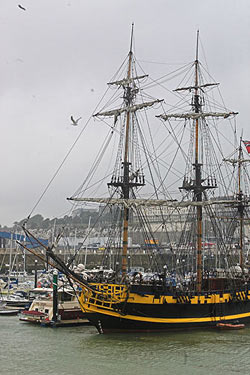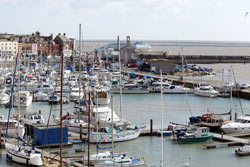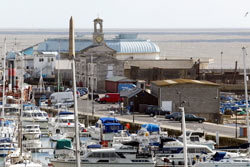Canon 70-200mm f/2.8 L IS
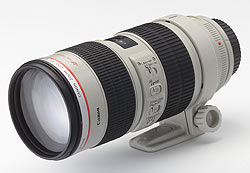 The 70-200mm f/2.8 L IS lens from Canon is possibly one of the most toted lenses carried by professional photographers around the world. Falling well into the category of medium telephoto and with a zoom ratio of just under 3x, just what is it that makes it so popular?
The 70-200mm f/2.8 L IS lens from Canon is possibly one of the most toted lenses carried by professional photographers around the world. Falling well into the category of medium telephoto and with a zoom ratio of just under 3x, just what is it that makes it so popular?
Canon 70-200mm f/2.8 L IS specifications
- Focal length 70-200mm
- Aperture f/2.8
- Angle of view
- Filter size / type 77mm
- Construction Elements/groups 23 elements in 18 groups
- Focusing type Internal USM
- Closest focus 1.4m
- Weight 1.47kg
- Dimensions (Dia x length) 86.2x197mm
- Mounts available Canon
- Tripod bush Yes, removable
- Price £1369
Build and Handling
The weight and build of this lens is what makes it really stand apart from the rest. The construction is second to none and the weight is accounted for in the materials used for the solid but pipe-like barrel. The lens remains the same length and orientation through all settings, making it easy to use filters on the 77mm thread.
Going away from the camera body you first come to the tripod collar. In front of that is the zoom ring marked at 70, 100, 135 and 200mm. It's smooth in operation and neither too loose nor too tight to turn. This ring has a double patterned grip in rubberised material that does not slip in the fingers, even when damp. Next comes the distance window that is practical but basic, lacking any attempt at a depth-of-field scale. Around the left of the barrel at this point are the focus and IS (Image Stabilisation) controls. Top is the focus limiter, a two position flush switch that limits the focus to 1.4m to infinity or 2.5m to infinity. Below this is a proud two-position switch to change from Manual to Autofocus.
Next down is the on/off switch for the IS system, another proud switch and finally a fourth switch, flush this time, that controls the IS mode, the choices being 1 & 2.
The next and last ring forward is the manual focus ring, again rubberised, this time with a triple pattern as a tactile difference to the zoom ring. It does seem a pity that manufacturers cannot keep these tactile patterns the same throughout their lens ranges. The focus ring is as smooth in operation as the zoom.
The whole lens is well enough made for Canon to claim it is dust and splash proof and, along with our lovely British weather, I managed to test these claims out in a couple of heavy downpours and a trip out to the Seal sandbanks in the Thames Estuary without any problems.
My one concern about the build of this lens, and it is one I am beginning to notice time and again, is the inability to remove the tripod mount ring without removing the lens from the camera. With concerns of dust entering the camera through the lens mount with modern dSLRs, the ability to remove the mount ring, for example when using a beanbag, without removing the lens from the camera would be an advantage. This one requires removing the lens, then lining up the red dots, a two handed job, before slipping it off over the lens mount. To achieve that, the camera needs to be put down or left swinging from a neck strap.
Performance
This lens performed admirably in all conditions and this is another area that it wins favour. The autofocus is virtually silent in operation, quick and accurate in finding its mark and locks on without hesitation. OK, I was using it on an EOS 1 series camera that is renowned for its own AF accuracy, but I did try the lens on an EOS 10D and it was still impressive.
Canon's Image stabilisation (IS) system, now in its second generation, does what it says on the tin and helps enormously when trying to hand hold a lens still. Canon claim up to three stops, and I won’t argue with that. You have to flick the switch from mode 1 to mode 2 for panning shots, which, once you spot a moving target, is easily forgotten, but if you are looking for or expecting them, is also very useful.
Although this lens uses second generation IS, which should work on a tripod without feedback, I got inconsistant results. It's not as bad as the Sigma OS system, which produces horrific results on tripod, but the Canon is still inconsistant. So I'd recommend turning off IS when the lens is tripod mounted as I still feel the two systems will fight each other with unpredictable results!
Optical quality
The benefits of Canon’s L Glass are well championed throughout the photographic world, so far be it for me to decry that here. I was, however, surprised to find that from a pure resolving ability, the lens was not head & shoulders above others. It did produce very pleasing images, with good contrast across the board and no discernable chromatic aberations. It also gave that slightly warm hue to the files that L glass is famous for. The other noticeable trait was that the degradation towards the edges of the frame was less noticeable than expected, despite the fact that it was tested on a camera that only has a 1.3x crop factor. The edge reading on the accompanying charts are taken at approx 75% of the distance from the centre to the corner of the frame so on a camera with a smaller sensor this would be at the limit of the sensor!
| 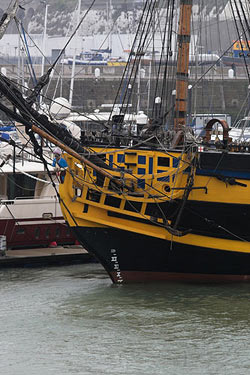 70-200mm set at 200mm |
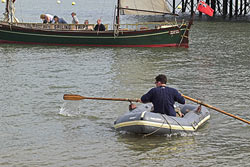 70-200mm set at 70mm | 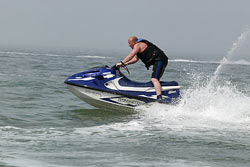 70-200mm set at 200mm |
Click on each comparision photo below to view full size versions
Below is our lens test data. To find out how to use these graphs look at this article: How we test lenses
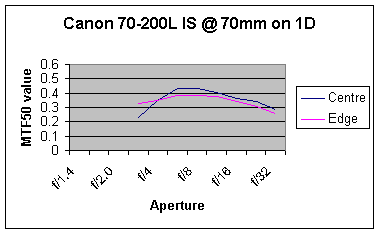
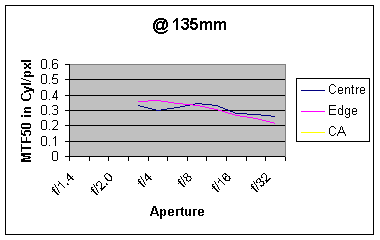
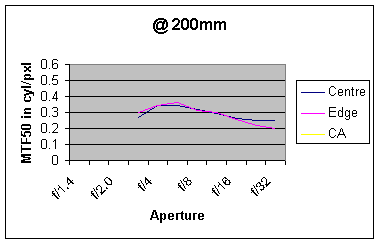
Verdict
It's easy to see why this lens is so popular or so high on people’s wish list. The build quality alone should ensure that whatever treatment is dished out to it, it will last a lifetime. With its wide open f/2.8 light gathering abilities, fast autofocus and the image stabilisation helping too, there will be no excuse that the lens wasn’t up to the job. Very little to pick holes in, save for the tripod mount ring, mentioned above. If you need a lens that works well in low light conditions, the consistency of this one wide open and towards the edges is admirable.
In summary the main positive points of the Canon 70-200mm f/2.8 L IS are:
![]() Build quality
Build quality
![]() Autofocus speed
Autofocus speed
![]() Optical quality (especially towards edges)
Optical quality (especially towards edges)
![]() Value for money (Feels like it will last forever)
Value for money (Feels like it will last forever)
Negative points are:
![]() Weight/balance (needs a heavy camera to balance)
Weight/balance (needs a heavy camera to balance)
![]() Tripod mount(difficult removal)
Tripod mount(difficult removal)
Check the latest price of the Canon 70-200mm f/2.8 L IS here
Test by Ian Andrews www.wildaboutkent.co.uk
regards prashanth
http://www.amazon.com/review/R310ALG0CQFDC5/ref=cm_cr_rdp_perm
I can't rave enough about the image quality in this new version. It was worth every penny I paid for it (the rebate sure helped!).
More Detail : http://webcamerawebcamera.com/detail.php?id_detail=Canon-70-200mm-f-2-8L-EF-IS-II-Telephoto-Zoom-Lens-USM-id172a&template=2
I want something longer than 200mm and was looking at the Canon 70-300mm IS 3.5-5.6 L.
However, given that the 20-200mm 2.8L is so universally highly regarded, I was wondering if I would be better with it and a teleconverter to get the length when I want it.
I know I will lose 2 stops, but starting at 2.8 that is not such a problem - but how will quality compare at say 300mm, between the 70-200 2.8 + converter and the 70-300 IS L?
Any advice is welcome.
Add your message
Please login here or if you've not registered, you can register here. Registering is safe, quick and free.
photodo Stats
428 MTF tests
74 in-depth photodo reviews
100+ users join each day
Help the lens community by reviewing or rating a lens today via our lens search
Latest Lens Reviews
- Chinon 28mm f/2.8 Vintage Lens Review
- Canon EF 70-200mm f/4L IS II USM Lens Review
- Samyang AF 85mm f/1.4 EF Review
- Sigma 70mm f/2.8 DG Macro Art Review
- Samyang AF 24mm f/2.8 FE Review
- Meike 50mm f/1.7 Review
- Tamron 70-210mm f/4 Di VC USD Review
- Lensbaby Burnside 35mm f/2.8 Review
- Asahi Super Takumar 50mm f/1.4 Review
- Asahi Super-Multi-Coated Takumar 135mm f/3.5 Review
